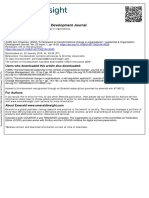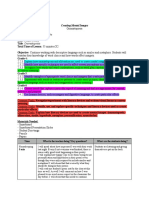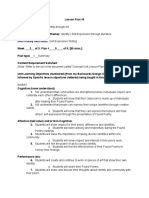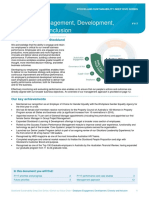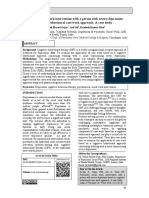0 ratings0% found this document useful (0 votes)
67 viewsLesson Plan Template Unabridged
Lesson Plan Template Unabridged
Uploaded by
api-266512667Copyright:
© All Rights Reserved
Available Formats
Download as DOCX, PDF, TXT or read online from Scribd
Lesson Plan Template Unabridged
Lesson Plan Template Unabridged
Uploaded by
api-2665126670 ratings0% found this document useful (0 votes)
67 views6 pagesOriginal Title
lesson plan template unabridged
Copyright
© © All Rights Reserved
Available Formats
DOCX, PDF, TXT or read online from Scribd
Share this document
Did you find this document useful?
Is this content inappropriate?
Copyright:
© All Rights Reserved
Available Formats
Download as DOCX, PDF, TXT or read online from Scribd
Download as docx, pdf, or txt
0 ratings0% found this document useful (0 votes)
67 views6 pagesLesson Plan Template Unabridged
Lesson Plan Template Unabridged
Uploaded by
api-266512667Copyright:
© All Rights Reserved
Available Formats
Download as DOCX, PDF, TXT or read online from Scribd
Download as docx, pdf, or txt
You are on page 1of 6
SETON HILL UNIVERSITY
Lesson Plan Template
TOPIC DETAILS CK
Name Miss Scott
Subject Reading Comprehension
Grade Level 1
st
Date/Duration October 2, 2014/10 minutes
Big Ideas Recognition of literary devices in poetry allows the reader to
understand the text more deeply and helps them interact with the
poem in a new way.
Essential Questions What is a literary device?
How do literary devices affect poetry?
PA/Common
Core/Standards
Read, understand, and respond to works of literature.
Recognize different types of genres such as poetry, drama,
and fiction.
Identify literary elements (characters, setting, and plot) in
selected readings
Identify literary devices in selected readings (e.g.,
personification, rhyming, alliteration).
Objectives
Bloom's Taxonomy
Webb's Depth of
Knowledge (DOK)
While reading a poem, students will individually be able to
determine at least one literary device used by the poet.
In groups of four, students will demonstrate their knowledge by
explaining to one another how they knew which literary device
was used in their poem.
Formative &
Summative
Assessment
Evidence
Students explanations
Walking around and seeing their work
Homework assignment
ISTE Standards for
Students
Framework for 21st
Century Learning
Elaborate, refine, analyze and evaluate their own ideas in
order to improve and maximize creative efforts
Develop, implement and communicate new ideas to others
effectively
Accommodations,
Modifications
Certain accommodations can be made that will be beneficial for students
with different disabilities:
During lessons in my class, we will have volunteer note takers.
Three to five students will be asked to do this per lesson as
necessary. They will take notes during the lesson. All the notes
will be copied and distributed to all the students so the students
can take information from that. This helps the student with
hearing impairments because they can now focus on the board
instead of trying to listen, read, and write at the same time. It will
also help students with ADHD or other learning disabilities by
reinforcing the lesson in a different way. It would even help the
students without disabilities.
Written and oral cues
Repetition
Poems will include pictures
Keeping an open line of communication between myself, the
student, and the parents
Student with ADHD
Seating the student near me
Seating the student next to people who will not distract him
Keep an eye out for quick frustration or lack of interest
Individually ask the student if he or she has any questions about
the lesson or the homework before the lesson is over
Provide extra time if needed
Student with Hearing Impairment
Provide written cues on top of oral cues
Speaking loudly and repeating what I or other students say
When in groups, the student will be assigned a volunteer helper.
This student will be someone for the student with hearing
impairments to ask questions to or ask to hear something
repeated.
Making sure the student did not miss anything during the lesson
by talking to them individually after class
Students with Learning Disabilities
Modified poems to match the students reading level
Provide this student with a self-developed file of vocabulary
words along with visual aids to relate words and ideas heard or
read throughout the lesson
Enlarge his or her poem to make it easier to see
Meet with the student individually before class is over to clarify
any questions and make sure the students information and
homework is organized
SUPERVISING
TEACHERS
SIGNATURE
Seton Hill University Lesson Plan Template Step-by-Step Procedures
RATIONALE for the
Learning Plan
This lesson is built upon the students ability to read and understand age
appropriate poems. After learning what a literary device is and reading
the poems, students will be able to go back and identify at least one
literary device used in their poem. Then, they will be able to listen to
others explanations with different literary devices, as well as explain
their own to their group.
CK
Introduction Activating Prior Knowledge
Question and Answer: 1) ask the students if they are familiar with
poetry: What is special about a poem? Do you know any
poems? etc. 2) ask the students if they know what onomatopoeia,
alliteration, rhyming, personification, and other literary devices are
Hook/Lead-In/Anticipatory Set
Students will be counted off into groups of 4s. They will be given
ten seconds to meet with their group members and sit back down.
Then, after answering the leading questions, students will learn the
key vocabulary.
Explicit
Instructions
Big Idea Statement
Recognition of literary devices in poetry allows the reader to
understand the text more deeply and helps them interact with the
poem in a new way.
Essential Questions Statement
What is a literary device?
How do literary devices affect poetry?
Objective Statement
While reading a poem, students will individually be able to
determine at least one literary device used by the poet.
In groups of four, students will demonstrate their knowledge by
explaining to one another how they knew which literary device
was used in their poem.
Transition
The students will get up and move before the lesson begins to join
their groups. They will have fifteen seconds to find their group
members while singing their ABCs. After the class discussion, the
students will transition into independent work by being asked to
take out their pencils in ten seconds or less. When they are
finished, they will put their pencils down. Students will transition
into group work by standing up when they are explaining their
literary device to their group. After group work, students will be
called back to their seats by shirt color and will be asked to put
their things away then to look at me when theyre done. Finally, we
will have a brief discussion at the end summarizing what the
students learned.
Key Vocabulary
Literary device: terms used to make writing more exciting. They
help the writer tell a story or make a point.
Personification: giving human qualities to an object or animal
Ex: Lightning danced across the sky. Traffic slowed to a crawl. Time
flies.
Rhyming: two or more words of phrases that end in the same
sound
Ex: The cat in the hat. Twinkle, twinkle, little star/How I wonder what
you are.
Alliteration: when words that start with the same sound (usually a
consonant) are used close together in a phrase or sentence.
Ex: Silly Sally sailed the seven seas. Lazy lizards lying like lumps.
Onomatopoeia: words that mimic the sound of an object or action
that it refers to.
Ex: arf, buzz, hiss, achoo, phew, shhh, clap
Lesson Procedure
Must include
adaptations &
accommodations
for students with
special needs
PreAssessment of Students
The students will be asked if they are familiar with the key
vocabulary. The vocabulary will be spoken and written on the
board for students.
Modeling of the Concept
The students will see the definition of the key vocabulary words on
the board along with an example. They will then be asked if to raise
their hands if they can come up with any examples.
Guiding the Practice
After the students begin to work individually, I will walk around
the room to assess their work and in case anyone has a question or
needs help. It is important to look for children that appear to be
struggling or see if there is one concept many children are having a
problem with. My students with disabilities will get my attention
first. The student will be spoken to in a calm, reassuring manner as
I ask him or her if they need any help or clarification before we
begin.
Providing the Independent Practice
The students will receive a poem and work independently for
about 5-10 minutes. They will be asked to read the poem and circle
the words or phrases that determine what literary device is used in
the poem. There will be modified poems for children with learning
disabilities. I will be there to help them as needed. Then, they will
get more practice in their groups.
Transition
The students will get up and move before the lesson begins to join
their groups. They will have fifteen seconds to find their group
members while singing their ABCs. After the class discussion, the
students will transition into independent work by being asked to
take out their pencils in ten seconds or less. When they are
finished, they will put their pencils down. Students will transition
into group work by standing up when they are explaining their
literary device to their group. After group work, students will be
called back to their seats by shirt color. Finally, we will have a brief
discussion at the end summarizing what the students learned.
Adaptations/Accommodations for Students with Special Needs
Certain accommodations can be made that will be beneficial for students
with different disabilities:
During lessons in my class, we will have volunteer note takers.
Three to five students will be asked to do this per lesson as
necessary. They will take notes during the lesson. All the notes will
be copied and distributed so the students can take information
from that. This helps the student with hearing impairments
because they can now focus on the board instead of trying to listen,
read, and write at the same time. It will also help students with
ADHD or other learning disabilities by reinforcing the lesson in a
different way.
Written and oral cues
Repetition
Poems will include pictures
Keeping an open line of communication between myself, the
student, and the parent
Student with ADHD
Seating the student near me
Seating the student next to people who will not distract him
Keep an eye out for quick frustration or lack of interest
Individually ask the student if he or she has any questions about
the lesson or the homework before the lesson is over
Provide extra time if needed
Student with Hearing Impairment
Provide written cues on top of oral cues
Speaking loudly and repeating what I or other students say
When in groups, the student will be assigned a volunteer helper.
This student will be someone for the student with hearing
impairments to ask questions to or ask to hear something
repeated.
Making sure the student did not miss anything during the lesson by
talking to them individually after class
Students with Learning Disabilities
Modified poems to match the students reading level
Provide this student with a self-developed file of vocabulary words
along with visual aids to relate words and ideas heard or read
throughout the lesson
Enlarge his or her poem to make it easier to see
Meet with the student individually before class is over to clarify
any questions and make sure the students information and
homework is organized
Evaluation of the
Learning/Mastery
of the Concept
Formal Evaluation
Homework assignment
Informal Evaluation
Walking around the room
Students explanations of their poems and the devices used to one
another
Closure Summary & Review of the Learning
This will come at the end of the lesson after students have
transitioned back into their seats. The students will be asked to
summarize what they learned about literary devices in their own
words. Then, they will be asked how those devices affect writing.
Do they make the writing more exciting? Is it easier to picture a
scene when literary devices are used? Questions will be projected
onto a screen as we are discussing them. Students will write key
words and phrases on the board throughout the discussion. Finally,
they will be assigned their homework. The homework assignment
will also be projected onto the board, and students will be provided
with their own set of directions as well.
Homework/Assignments
Students will write their own short poem including at least one
literary device of their choice one that they did not use for their
poem in class.
Reading Materials
Technology
Equipment
Supplies
Various poems
Modified poems for students with disabilities
Teacher
Self-reflection
Teaching a first grade lesson to adults was a difficult challenge, but
this activity gave me a taste of what its like to actually be teaching.
The hardest part for me was pacing the lesson. I ended up with a
few minutes left over. Also, I found that I got ahead of myself a few
times. I would begin to talk about something before thoroughly
going through the previous concept. With young children, it is vital
to be thorough with important information to ensure they
understand it. This was a great practice for me, and the feedback I
received from my group members really helped me improve my
lesson plan. They all had great examples that I could learn from,
too. I enjoyed teaching my first lesson and will take a lot away
from this assignment.
Although modifying lessons to suit to children with different
special needs can be difficult, it is not impossible. Every student
deserves the same chance at learning whether they have mental
disabilities, physical disabilities, or both. It is very fulfilling and
satisfying to know that by modifying my lessons and
understanding a students disability, I can make learning fun for
him or her. My attitude, behaviors, and accommodations can make
all the difference in that childs school experience. As a teacher, it is
my job to make sure every childs experience is a worthwhile one.
You might also like
- Acrostic Poem Lesson PlanDocument4 pagesAcrostic Poem Lesson Planapi-306040952No ratings yet
- A Framework For Transformational Change in OrganisationsDocument12 pagesA Framework For Transformational Change in OrganisationsSeethalakshmy NagarajanNo ratings yet
- Suit Against Kirk Smith, Religious Community ServicesDocument69 pagesSuit Against Kirk Smith, Religious Community ServicesThe Republican/MassLive.comNo ratings yet
- Draft LessonDocument4 pagesDraft Lessonapi-266512667No ratings yet
- Instructional Lesson Plan: I. Purpose of The LessonDocument6 pagesInstructional Lesson Plan: I. Purpose of The Lessonnatalies15No ratings yet
- Poetry Lesson 1 AlliterationDocument6 pagesPoetry Lesson 1 Alliterationapi-213611948No ratings yet
- Courtois 408lab AnnotatedlessonDocument7 pagesCourtois 408lab Annotatedlessonapi-252890465No ratings yet
- Introduction Day 1Document4 pagesIntroduction Day 1api-283596397No ratings yet
- Animal AcrosticsDocument3 pagesAnimal Acrosticsapi-183214315No ratings yet
- Spe 480 Student Academic Lesson PlanDocument13 pagesSpe 480 Student Academic Lesson Planapi-404422607100% (1)
- Educ-302-Lesson One RevisionDocument7 pagesEduc-302-Lesson One Revisionapi-252316801No ratings yet
- Grade Level: 4 Lesson Duration: 2 Hours: "Three Young Pilgrims" Poetry Challenge MOPTA Lesson Plan FormatDocument19 pagesGrade Level: 4 Lesson Duration: 2 Hours: "Three Young Pilgrims" Poetry Challenge MOPTA Lesson Plan Formatapi-341318966No ratings yet
- Vocabulary Toolkit 1Document4 pagesVocabulary Toolkit 1api-316809787No ratings yet
- Lesson1 2Document3 pagesLesson1 2api-270339587No ratings yet
- 477 Lesson Plan Summer 2013Document12 pages477 Lesson Plan Summer 2013tddhondtNo ratings yet
- Writing Lesson Plan: Title: Writing Musical TablesDocument13 pagesWriting Lesson Plan: Title: Writing Musical Tablesapi-455835172No ratings yet
- Lesson 3 - Formal ObservationDocument4 pagesLesson 3 - Formal Observationapi-306088393No ratings yet
- Educ-302-Lesson Four FinalDocument4 pagesEduc-302-Lesson Four Finalapi-252316801No ratings yet
- Beed 3101 Group 6Document15 pagesBeed 3101 Group 6rhealyn8lizardoNo ratings yet
- Champion Language Arts November 21Document2 pagesChampion Language Arts November 21api-275750758No ratings yet
- Competency 34 6Document3 pagesCompetency 34 6api-302250677No ratings yet
- Edu 112 LD Lesson PlanDocument2 pagesEdu 112 LD Lesson Planapi-317483712No ratings yet
- Practicum III - Poetry UnitDocument10 pagesPracticum III - Poetry Unitapi-257946648No ratings yet
- Read Aloud Lesson PlanDocument6 pagesRead Aloud Lesson Planapi-349922174No ratings yet
- Poetry Lesson PlanDocument11 pagesPoetry Lesson Planapi-317919141No ratings yet
- Writing ProgramDocument11 pagesWriting Programapi-251358625No ratings yet
- Genre Project Unit PlanDocument45 pagesGenre Project Unit Planapi-242273696No ratings yet
- Poetry Lesson 3 - SimilesDocument6 pagesPoetry Lesson 3 - Similesapi-213611948No ratings yet
- Lesson Plan Activist Poster 3Document9 pagesLesson Plan Activist Poster 3api-549376775No ratings yet
- Lesson5 Guided ReadingDocument3 pagesLesson5 Guided Readingapi-358126937No ratings yet
- Lesson Plan Poetry AyalaDocument30 pagesLesson Plan Poetry Ayalaapi-328817872No ratings yet
- Day 1 LessonDocument3 pagesDay 1 Lessonapi-284253105No ratings yet
- Reflective Lesson Plan (Video Lesson) Personification and HyperboleDocument7 pagesReflective Lesson Plan (Video Lesson) Personification and HyperbolenscmanigaultNo ratings yet
- Direct Instruction Lesson Plan TemplateDocument6 pagesDirect Instruction Lesson Plan Templateapi-312985671No ratings yet
- Lesson 12 - OnomatopoeiaDocument2 pagesLesson 12 - Onomatopoeiaapi-265318262No ratings yet
- Poetry Lesson 2 ExaggerationDocument7 pagesPoetry Lesson 2 Exaggerationapi-213611948No ratings yet
- Grimesey lp9 FinalDocument3 pagesGrimesey lp9 Finalapi-341187427No ratings yet
- Poetry Lesson 5Document3 pagesPoetry Lesson 5api-213547236No ratings yet
- Listening Lesson Plan (BC)Document5 pagesListening Lesson Plan (BC)Yee Mon AungNo ratings yet
- Writing Lesson - The Little Scarecrow BoyDocument3 pagesWriting Lesson - The Little Scarecrow Boyapi-252682790No ratings yet
- Poetry Lesson Plan-Free Verse 1Document3 pagesPoetry Lesson Plan-Free Verse 1api-456703108No ratings yet
- Additional LessonsDocument5 pagesAdditional Lessonsapi-471199133No ratings yet
- Victoria King Dystopian Unit Lesson 3 Directed Listening and ThinkingDocument3 pagesVictoria King Dystopian Unit Lesson 3 Directed Listening and Thinkingapi-272573842No ratings yet
- Turtles Race W Beaver Lesson PlanDocument6 pagesTurtles Race W Beaver Lesson Planapi-245081461No ratings yet
- Lesson Plan Form Teacher Education Department CSUDH Vocabulary and ComprehensionDocument4 pagesLesson Plan Form Teacher Education Department CSUDH Vocabulary and Comprehensionapi-331077824No ratings yet
- Lesson Plan Esl AccDocument3 pagesLesson Plan Esl Accapi-268931692No ratings yet
- Lesson 4 Sensory PoemsDocument7 pagesLesson 4 Sensory Poemsapi-302459286No ratings yet
- Elllessonplan 2Document8 pagesElllessonplan 2api-280067112No ratings yet
- Poetry UnitDocument3 pagesPoetry Unitapi-251530394No ratings yet
- Visualization Esl Full Class Lesson PlanDocument6 pagesVisualization Esl Full Class Lesson Planapi-255816892No ratings yet
- Concept Unit Day 2 - RewriteDocument8 pagesConcept Unit Day 2 - Rewriteapi-266951442No ratings yet
- Engl 9 - Backdrop Addresses CowboyDocument4 pagesEngl 9 - Backdrop Addresses Cowboyapi-2922901830% (1)
- Lesson Plan Five - Nature PoetryDocument6 pagesLesson Plan Five - Nature Poetryapi-323577556No ratings yet
- High School Disney Lesson Plan Gender StereotypesDocument5 pagesHigh School Disney Lesson Plan Gender Stereotypesapi-317787820No ratings yet
- Poetry Is All Around UsDocument42 pagesPoetry Is All Around UsFlin Eavan100% (2)
- Clip The Vowel Lesson PlanDocument4 pagesClip The Vowel Lesson Planapi-236986052No ratings yet
- Language Oct 24, 2022Document11 pagesLanguage Oct 24, 2022Omar GollabNo ratings yet
- Literacy Lesson 2Document4 pagesLiteracy Lesson 2api-284988905No ratings yet
- Final Lesson Plan and ReflectionDocument6 pagesFinal Lesson Plan and Reflectionapi-301164351100% (2)
- Lesson Plan Identities OneDocument5 pagesLesson Plan Identities Oneapi-301956295No ratings yet
- Fluency LessonDocument5 pagesFluency Lessonapi-240726864No ratings yet
- Unlocking the Poem: A Guide to Discovering Meaning through Understanding and AnalysisFrom EverandUnlocking the Poem: A Guide to Discovering Meaning through Understanding and AnalysisNo ratings yet
- Physiotherapy and Mental Health: Michel ProbstDocument22 pagesPhysiotherapy and Mental Health: Michel ProbstAntónioAbraçosNo ratings yet
- J Midwife Womens Health - 2021 - Likis - Inclusive Language Promotes Equity The Power of WordsDocument4 pagesJ Midwife Womens Health - 2021 - Likis - Inclusive Language Promotes Equity The Power of WordsNorma CruzNo ratings yet
- Deconstructing Language Practices: Discursive Constructions of Children in Individual Education Plan Resource DocumentsDocument19 pagesDeconstructing Language Practices: Discursive Constructions of Children in Individual Education Plan Resource DocumentsEdith IndekNo ratings yet
- Employee Engagement Development Inclusion FY17 PDFDocument19 pagesEmployee Engagement Development Inclusion FY17 PDFAli Alsari AlhashemiNo ratings yet
- Detailed Advt - ET Fin - 0Document8 pagesDetailed Advt - ET Fin - 0BrahmanandaNo ratings yet
- Agoraphobia CuredDocument154 pagesAgoraphobia CuredPanos KoutselinisNo ratings yet
- Bipolar Disorder: Best Practices in Screening, Diagnosis and TreatmentDocument51 pagesBipolar Disorder: Best Practices in Screening, Diagnosis and TreatmentKay BristolNo ratings yet
- (Routledge Research in Health Communication) Annette Madlock Gatison (Ed.) - Communicating Women's Health - Social and Cultural Norms That Influence Health Decisions-Routledge (2016)Document208 pages(Routledge Research in Health Communication) Annette Madlock Gatison (Ed.) - Communicating Women's Health - Social and Cultural Norms That Influence Health Decisions-Routledge (2016)tazzycaNo ratings yet
- Cumulative Stigma Among Injured ImmigrantDocument15 pagesCumulative Stigma Among Injured ImmigrantJoan Sebastian Arbelaez CaroNo ratings yet
- Thesis On Equality and DiversityDocument7 pagesThesis On Equality and Diversityangelaweberolathe100% (2)
- Sukbunpant 2013Document14 pagesSukbunpant 2013Javiera Inés Palacios TapiaNo ratings yet
- What Is Disability? What Is Ableism?: Society For The Psychological Study of Social IssuesDocument2 pagesWhat Is Disability? What Is Ableism?: Society For The Psychological Study of Social IssuesJody Abot100% (1)
- All Means All UNESCO 2020Document28 pagesAll Means All UNESCO 2020Isabel CarrilesNo ratings yet
- 4 Harry Kavacs Class TaskDocument2 pages4 Harry Kavacs Class TaskSamia FarooqNo ratings yet
- Inclusiveness PowerPoint ExamClass!Document123 pagesInclusiveness PowerPoint ExamClass!abiybelay1872No ratings yet
- Paper Culturele StromingenDocument9 pagesPaper Culturele StromingenLaureCatherine BeyersNo ratings yet
- Psychiatric Social Work Intervention With A Person With Severe Depression Based On Cognitive Behavioural Case Work Approach: A Case StudyDocument7 pagesPsychiatric Social Work Intervention With A Person With Severe Depression Based On Cognitive Behavioural Case Work Approach: A Case StudyKamlesh Kumar SahuNo ratings yet
- Solved SSC Stenographer 6th Feb 2019 Shift-II Paper With SolutionsDocument58 pagesSolved SSC Stenographer 6th Feb 2019 Shift-II Paper With SolutionsDivya tejaNo ratings yet
- Botswana PDFDocument42 pagesBotswana PDFJasiz Philipe OmbuguNo ratings yet
- Moot Problem No. 5 RespondantDocument28 pagesMoot Problem No. 5 RespondantRajan RajNo ratings yet
- 1995 Health Ethnicity PovertyDocument116 pages1995 Health Ethnicity PovertyKevin ChapleyNo ratings yet
- Disclosing A Disability - Do Strategy Type and Onset Controllability - Lyons2017Document10 pagesDisclosing A Disability - Do Strategy Type and Onset Controllability - Lyons2017hafiz10041976No ratings yet
- Final Version PDFDocument26 pagesFinal Version PDFSamuel Budi SetijonoNo ratings yet
- Workshopuri SibiuDocument21 pagesWorkshopuri SibiuDyana AnghelNo ratings yet
- Failure To Launch Resources Handout 1162014Document4 pagesFailure To Launch Resources Handout 1162014Johan Cardona SarriaNo ratings yet
- Disruptive Behavior Disorders NotesDocument14 pagesDisruptive Behavior Disorders NotesAngela RegalaNo ratings yet
- CMH - Merged End Term PDFDocument320 pagesCMH - Merged End Term PDFSrishti KumarNo ratings yet
- Accessible TourismDocument58 pagesAccessible TourismObinna OnwumeluNo ratings yet

